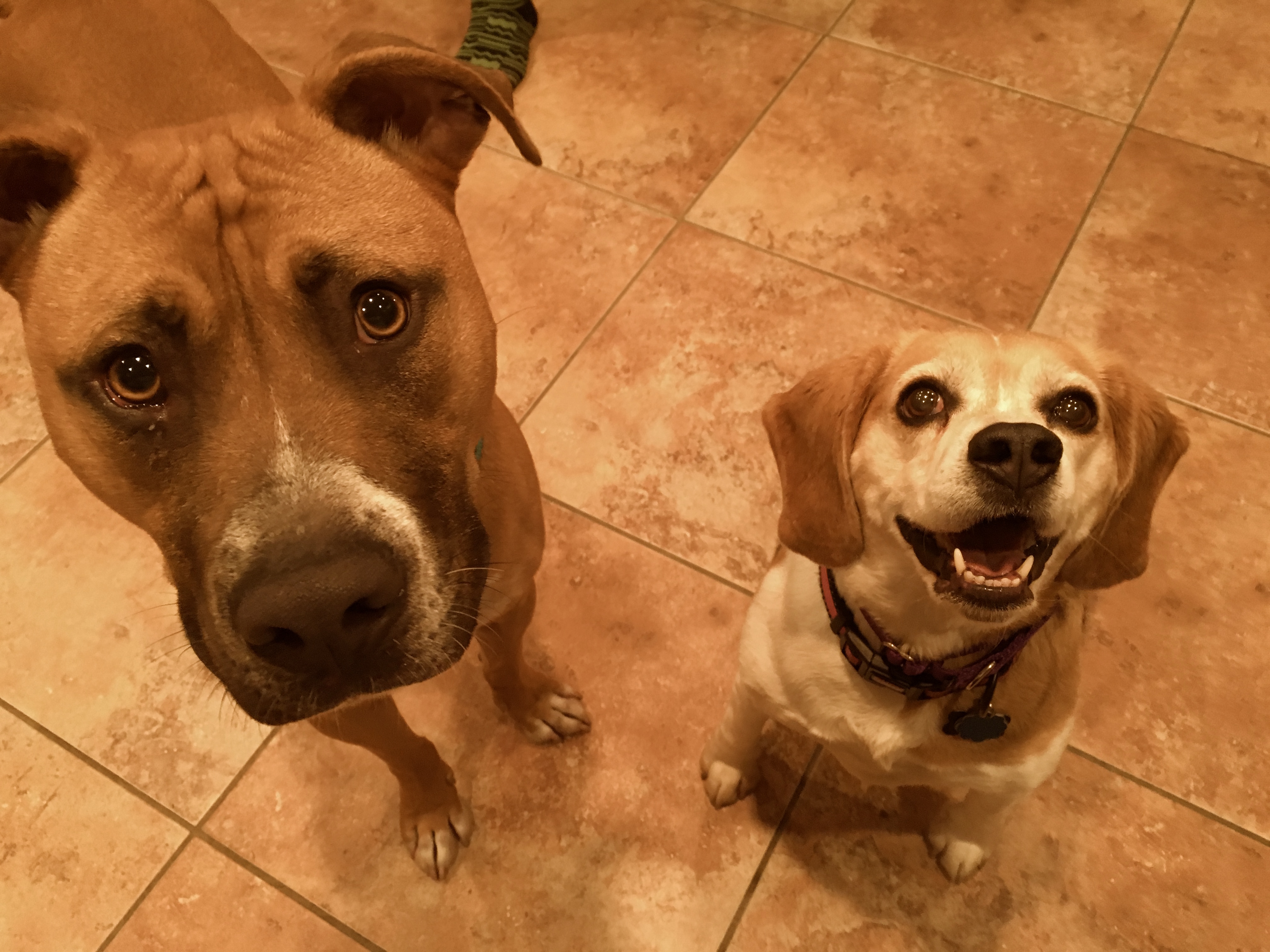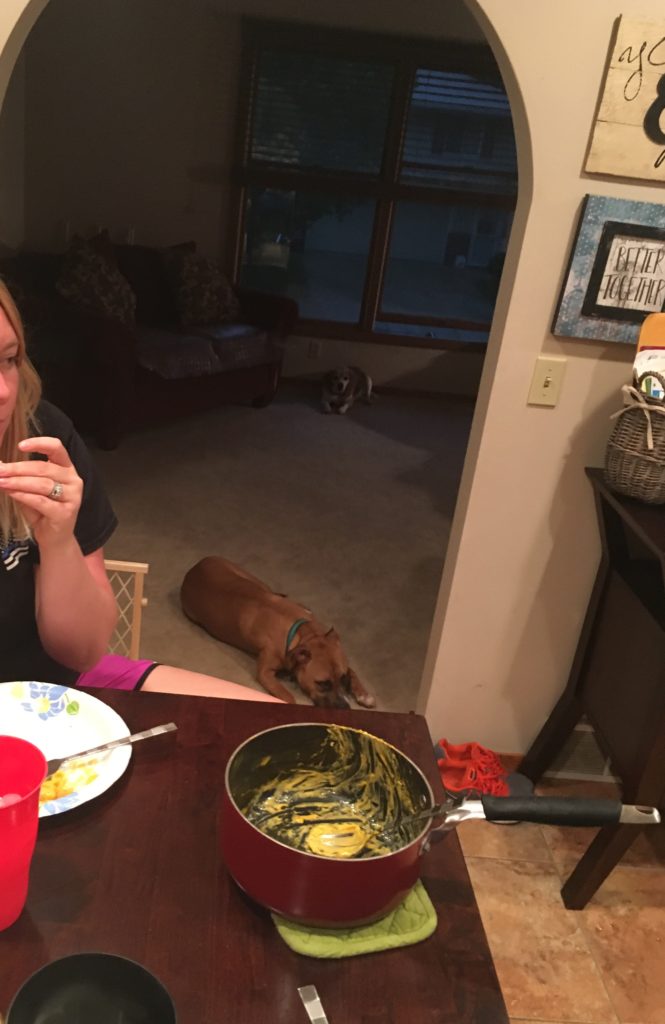Training a Beagle and Pit Bull Mix to Respect Their Guardians
By: David Codr
Published Date: May 12, 2016
Roman (left) is a one-year-old Boxer Pit mix in Omaha who likes to hump, barks for attention, gets over excited and is dog reactive – especially to dogs or people passing by the common area behind the house. His room mate Charlie is a nine-year-old female Beagle who ramps up Roman’s excitement with a whole lot of barking.
To say that Charlie riled things up it was a bit of an understatement. The dog’s guardians kept them behind a barrier which prevented them from reaching the front door. However this barrier did not stop Charlie’s howl-barking an alert of my arrival.
Once inside, I sat down with the dog’s guardians to discuss what they want to do accomplish in the session. Usually I start out this conversation by saying “how can I help you,” but Roman decided that he was going to communicate that for them.
Roman repeatedly grabbed and hugged my shin with his front two arms and tried to do the wild thing on my leg. I had to correct him multiple times as he was very determined to show me that he was the boss.
This was more of a playful mounting, but still an attempt by the dog to show me that he was in charge. I used this opportunity to discuss how important it is to have rules and structure in a dogs life.
I also went over a technique that I like to use called Petting with a purpose.
Roman and Charlie’s guardians had been attempting to incorporate rules and structure, but the way they had done it wasn’t sending the message they wanted to convey.
Because they were using tools (tethers or baby gates) to block the dogs or limit them, the dogs looked at the tools as the authority figures rather than the humans.
To help the dogs start to see and identify their humans as being the authority figures in the home, I went over a series of escalating consequences that I like to apply whenever a dog does something I disagree with or breaks a rule.
After going over the escalating consequences and suggesting some rules and structure for the family to incorporate, I demonstrated how they could use the escalating consequences to keep Roman out of the kitchen without using a physical barrier.
This sort of dog obedience training can be applied to many different situations. It will be important for the guardians to practice this technique multiple times a day and look for ways to incorporate it into everyday activities.
By adding rules and structure into the dog’s daily life and routine, the guardians don’t need to take Roman to dog school. But by incorporating these dog training principles in the little things the dogs participates in, we can eliminate many unwanted actions through this type of dog behavior training.
Next I went over a technique that the family can use whatever Roman decides to try to mouth them. This is a behavior that most dogs learn to avoid in puppy classes. But if everyone in the family consistently uses the same technique, it shouldn’t take long for Roman to learn that mouthing is not allowed.
One of the last things we touched on was Roman’s reactivity to other dogs when on the leash. We call this leash aggression and it is not a uncommon problem for dogs that did not get a lot of socialization in puppy classes.
I pulled out a few high-value treats and attempted to show Roman’s guardians how they can train him to look at them when he spots another dog rather than barking his disapproval. This is a technique developed by a Dog Behaviorist friend of mine, Karen London, which she detailed in her book Feisty Fido.
Roman was over excited due to a lack of constructive exercise earlier in the day. This combined with his extreme attraction to the high-value treats that I used made it difficult to implement the technique with everything else we had implemented in the session.
I used this opportunity to show how important it is for his guardians to make sure that Roman is getting a sufficient amount of exercise, every day. His guardians may need to modify the times they take him for a walk to avoid encountering other dogs while they are teaching him the Watch command.
But once his guardians can master this Watch exercise, they will be able to freely walk around the neighborhood without any concern for an unexpected encounter with another dog.
Later in the evening of the day of the session, Roman’s guardians texted me a picture of the dogs respecting the boundary to the kitchen with the quote “First time e’ve ate in peace in almost a year!”
By the end of the session I started to notice a difference in Roman. He was not invading people’s personal space, had stopped jumping up, had given up trying to hump me and seemed to be following his guardians lead and corrections right away.
If the guardians consistently enforce the new rules and boundaries, the structure we added should help the dog start to identify as being in a follower position. Once the dogs see the humans as being the authority figures, they will stop pushing the boundaries as much and instead defer whenever the humans correct them.
It’s going to take a week or two of practice at the Watch exercise before Roman will be ready to start encountering other dogs. Once that is the case his guardians will need to find a location where they can see approaching dogs at a great distance. This will allow them to redirect Roman’s gaze towards them and away from the other dog. If the other dog is too close, it will be impossible for Roman’s guardians to get him to look away.
I asked Romans guardians to follow up with me in three or four weeks with a progress report. There are certainly other techniques that we can incorporate if the Watch exercise does not do the trick. But based on the guardian’s comments that he only is reactive to other dogs went on a leash, mastering the watch exercise after changing the leadership dynamic should do the trick.
Categorized in: Dog Behavior



